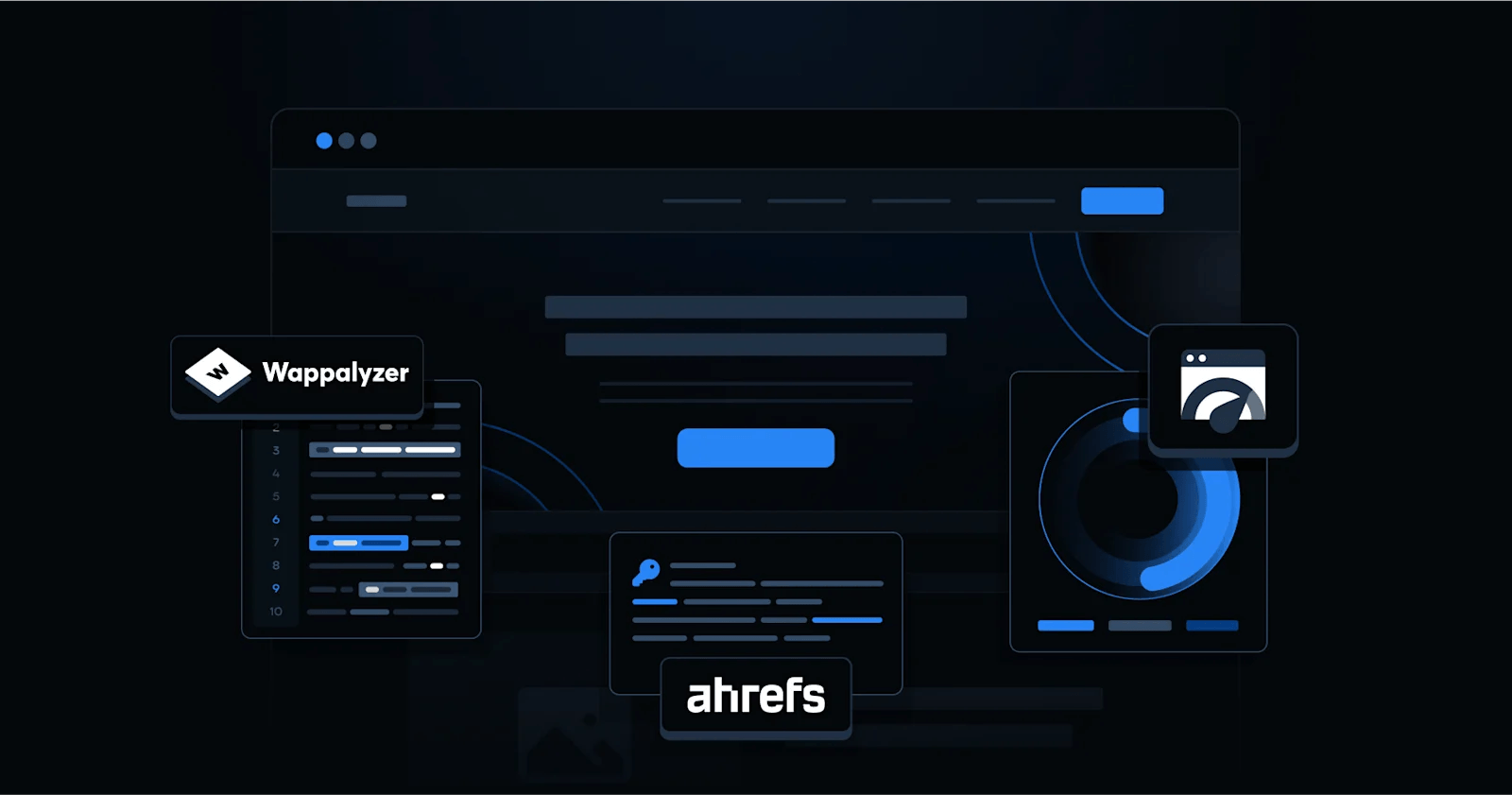Enterprise website migrations are a big deal, and it’s not something you want to take lightly. Imagine moving a massive, complex website to a new home. It’s like relocating a bustling city without losing any of its charm or functionality.
As an agency for enterprise websites, we want to share the essentials of large-scale website migrations, ensuring you know what to expect and how to prepare.
What is Enterprise Website Migration?
Enterprise website migration involves moving a large, complex website from one platform, domain, or URL structure to another. This process can include shifting from a monolithic to a headless architecture, consolidating multiple domains, or overhauling site navigation.
For example, you might transition from a traditional CMS to a more flexible, headless CMS to improve website performance and scalability. Or, you might merge several domains into one to streamline your online presence and enhance brand consistency. Overhauling site navigation can also be part of the migration, making it easier for users to find what they need.
Migrations can significantly impact SEO, user experience, and business operations. If not carefully planned and executed, you risk losing search engine rankings, confusing users, and disrupting business processes. Proper planning and execution are vital to ensure a smooth transition and maintain the benefits of your current setup while gaining the advantages of the new one.

Why Enterprise Website Migration Matters
As large-scale orgs evolve, their websites must keep pace. Whether it's rebranding, expanding features, or improving performance, migrating your enterprise website can unlock new opportunities. However, without proper planning, it can also pose significant risks. At Webstacks, we've guided numerous enterprises through successful migrations, and we're here to share our expertise.
Whether you're upgrading from an outdated WordPress environment or switching headless CMS platforms, your new CMS should give marketers (and your users) the best experience possible.
What Types of Enterprise Website Migrations Are There?
Understanding the different types of migrations is crucial to address specific needs and challenges. Let's break them down.
Platform Migration
Platform migration involves moving your website from one CMS, ecommerce platform, or backend system, to another. This type of replatforming can be driven by the need for better functionality, improved performance, or enhanced scalability. For instance, you might switch from a traditional CMS to an enterprise-grade CMS to gain more flexibility in content delivery.
When migrating platforms, you will need to transfer things like content, media (images and videos), documents, and data.
Choosing the best CMS requires meticulous planning to ensure that all data, content, and functionalities are transferred seamlessly without disrupting the user experience.
Domain Migration
Domain migration entails changing the primary domain name of your website. This often happens during rebranding efforts or after a company acquisition. For example, if your company merges with another, you might need to consolidate both websites under a single, unified domain.
This type of migration can significantly impact your enterprise's SEO, as search engines need to reindex the new domain. Thus, you must thoroughly consider before merging websites. Properly setting up 301 redirects from the old domain to the new one is crucial to preserve search rankings and avoid traffic loss. Additionally, updating all marketing materials, backlinks, and internal links to reflect the new domain is essential for a smooth transition.
URL Structure Migration
URL structure migration involves revamping the paths, parameters, and hierarchy of your website's URLs. This can include changing the format of your URLs to make them more user-friendly and SEO-friendly. For example, you might switch from a URL structure that uses query parameters (e.g., example.com/page?id=123) to a more readable format (e.g., example.com/page-name).
This type of migration can improve your site's navigation and make it easier for users and search engines to understand the content hierarchy. However, it requires careful planning to ensure that all old URLs are properly redirected to their new counterparts to avoid broken links and loss of traffic.
HTTP to HTTPS
Transitioning your website from HTTP to HTTPS is another common type of migration. This involves moving your entire site to a secure protocol, which encrypts data transmitted between the user's browser and your server. HTTPS is now a standard for websites, as it enhances security and is favored by search engines. T
his type of migration requires obtaining an SSL certificate and updating all internal links, scripts, and resources to use the HTTPS protocol. Additionally, you need to set up 301 redirects from HTTP to HTTPS to ensure that users and search engines are directed to the secure version of your site.
What Are the Benefits of a Successful Enterprise Migration?
You might be wondering, why go through all this trouble? Well, a successful migration can bring substantial benefits.
Improved Site Architecture
A successful enterprise migration allows you to clean up and optimize your site's architecture. This includes refining your URL structure and internal linking. A well-organized URL structure makes it easier for search engines to crawl and index your site, improving your SEO performance. Internal linking helps distribute page authority throughout your site, enhancing the visibility of important pages. By addressing these elements during migration, you can create a more navigable and SEO-friendly website.
Enhanced User Experience
Implementing modern designs, features, and functionality during migration can significantly enhance the user experience, as these are few of the best B2B website practices. A fresh design can make your site more visually appealing and easier to navigate.
Adding new features, such as improved search functionality or interactive elements, can engage users and keep them on your site longer. Upgrading your site's functionality ensures that it meets current user expectations and provides a seamless experience across all devices.
Faster Page Speed
Switching to a high-performance hosting environment, building a scalable website, or adopting a headless setup can drastically improve your site's page speed. Faster loading times enhance user satisfaction and reduce bounce rates.
A high-performance hosting environment ensures that your site can handle increased traffic without compromising speed. Moving to a headless setup decouples the front-end and back-end, allowing for faster content delivery and a more responsive user experience. These improvements can lead to higher search engine rankings and better overall performance.
Unified Tracking and Analytics
Consolidating domains and properties during a migration provides an opportunity to unify your tracking and analytics. This holistic approach allows you to measure performance across your entire digital presence more effectively. Unified tracking helps you understand user behavior, identify trends, and make data-driven decisions. By having all your data in one place, you can gain deeper insights into your audience and optimize your marketing strategies for better results.
Planning and Preparing for Enterprise Website Migration
Proper planning and preparation are the cornerstones of a successful enterprise website migration. At Webstacks, we've learned that a structured approach can make the difference between a seamless transition and a chaotic one.
Key Steps for a Successful Migration Plan
To navigate the complexities of enterprise website migration, it's crucial to follow a structured plan:
- Define Migration Objectives: Clearly outline your goals, such as rebranding, moving to a new content management system, or enhancing performance. Understanding your objectives helps align the migration with your business strategy.
- Conduct a Comprehensive Content Audit: Inventory all existing content and URLs to determine what to migrate, update, or remove. Tools like Screaming Frog can assist in crawling your site and gathering data.
- Develop a Detailed Migration Strategy: Establish a step-by-step plan with timelines, resource allocation, and risk assessments. Assign roles and responsibilities to ensure accountability.
- Backup and Staging: Create full backups of your site and set up a staging environment to test the migration process without affecting the live site. This allows you to identify and fix issues in a safe environment.
- Map Out URL Changes and Redirects: Plan for URL structure preservation or implement appropriate 301 redirects to maintain SEO rankings. A comprehensive redirect map is essential.
- Implement a Robust Testing Strategy: Test all functionalities in the staging environment, including links, forms, and navigation, to identify and fix issues before going live.
- Update Integrations and APIs: Ensure that all third-party integrations are compatible with the new platform to prevent disruptions.
- Set Up Analytics and Tracking: Configure analytics tools on the new site to monitor performance post-migration and make data-driven decisions.
Stakeholder Communication Strategies
Effective communication with stakeholders is essential during the migration process:
- Internal Communication: Keep your team informed about the migration timeline, roles, and responsibilities to ensure coordination and prevent misunderstandings.
- External Communication: Notify clients and customers about upcoming changes or potential downtime to manage expectations and maintain trust.
- Use Communication Tools: Leverage tools like Slack, Jira, and Zoom for transparent communication throughout the project, fostering collaboration and quick issue resolution.

What Key Considerations Should You Keep in Mind?
There are several important factors to consider to ensure a successful migration.
Avoid Launching Near Peak Seasons
Launching a migration during peak seasons like holidays or major sales events can disrupt business operations and customer experience. High traffic periods increase the risk of issues going unnoticed or unresolved quickly. Choose a quieter time to ensure your team can focus on the migration without the added pressure of peak season demands.
Allocate Resources For Unexpected Issues.
Migrations often come with unforeseen challenges. Allocate additional time and resources to handle these surprises. This includes having extra personnel on standby and a contingency budget for any unexpected costs. Being prepared for the unexpected ensures that minor issues don't escalate into major problems.
Robust Monitoring Pre And Post Migration.
Set up comprehensive analytics and monitoring systems before and after the migration. This helps track performance metrics and identify any issues early. Use tools like Google Analytics and server monitoring software to keep an eye on traffic, page load times, and error rates. Post-migration, continuous monitoring helps ensure the new setup performs as expected and allows quick adjustments if needed.
Partner with Experienced Teams
Work with teams that have a proven track record in handling enterprise migrations and managing large-scale web operations. Teams experienced in enterprise web development can provide valuable insights and solutions. Their expertise helps mitigate risks and ensures a smoother transition. Collaborate closely with these teams to leverage their knowledge and skills.
Communicate Timelines & Progress
Keep all website stakeholders informed throughout the migration process. Regular updates on timelines and progress help manage expectations and reduce anxiety. Use clear and frequent communication to ensure everyone understands their roles and responsibilities. This transparency helps build trust and ensures that any issues are addressed promptly.
Technical Considerations and Challenges in Enterprise Website Migration
Migrating an enterprise website involves technical complexities that require meticulous project planning and execution. Understanding the common challenges and infrastructure requirements is crucial to ensure a seamless transition.
Common Technical Challenges in Migrations
Enterprise-level migrations come with unique challenges that can impact your website's performance and SEO if not properly addressed:
- Preserving SEO Rankings: Maintaining search engine rankings is a primary concern. This involves creating comprehensive 301 redirect maps, preserving metadata, and updating internal links to reflect the new site structure.
- Content Migration: Transferring extensive amounts of content while maintaining formatting, links, and SEO elements can be daunting. Conducting a thorough content audit helps identify what needs to be migrated, updated, or removed.
- Legacy Issues: Dealing with problems like 404 errors, duplicate content, and redirect chains is essential. These issues can negatively affect user experience and search engine visibility.
- Technical SEO Implementation: Reimplementing technical SEO elements such as structured data, canonical tags, and hreflang attributes requires careful attention to maintain search performance.
- Integration Challenges: Updating or replacing third-party integrations and APIs to ensure compatibility with the new platform is necessary. Failure to address these can lead to functionality breakdowns.
- Testing and Quality Assurance: Comprehensive testing across browsers, devices, and functionalities is critical. Overlooking issues can result in poor user experience or site downtime.
Infrastructure Needs and Server Configurations
The technical infrastructure supporting your enterprise website plays a pivotal role in performance and scalability during and after migration:
- Server Resources and Configuration: Ensuring servers are properly configured and have sufficient resources is vital. This includes optimizing server settings for performance, security, and scalability.
- Scalability and Performance Optimization: Implementing efficient caching mechanisms and using content delivery networks (CDNs) can enhance site speed and handle high traffic loads effectively.
- Platform Selection: Choosing the right platform or architecture, such as a headless CMS or composable architecture, affects how your infrastructure needs to be set up. Compatibility with existing systems and future scalability should guide this decision.
- Security Measures: Implementing enterprise security protocols protects against potential threats during migration. This includes securing data transfer and ensuring compliance with data protection regulations.
- Cloud Services and Hosting: Deciding between on-premises servers, cloud-based solutions, or hybrid models impacts your server configuration and maintenance responsibilities.
- Backup and Recovery Plans: Establishing reliable backup systems and recovery procedures safeguards your data against unforeseen issues during the migration process.
How Do You Plan an Enterprise Website Migration?
Planning is everything when it comes to a successful migration. Here's how to get started.
Audit Existing Site
Start by crawling your entire site to inventory all URLs, redirects, and assets. Use tools like Screaming Frog or Sitebulb to get a comprehensive list of everything on your site. This step helps you understand the current structure and identify any existing issues. Document all URLs, noting which ones are active, which are redirected, and which might be obsolete. This inventory will serve as the foundation for your migration plan.
Map URL Redirects
Next, define your URL redirects. This involves creating a detailed map of 1:1, and regex redirects from old URLs to new ones. A 1:1 redirect means each old URL points directly to a specific new URL. Regex redirects allow you to use patterns to redirect multiple URLs efficiently. For example, if you're changing a directory structure, a regex redirect can handle all URLs within that directory. Ensure every old URL has a corresponding new URL to avoid broken links and maintain SEO value.
Benchmark Performance
Document the current performance of your site. This includes tracking traffic, rankings, and conversions for each page. Use tools like Google Analytics and Google Search Console to gather this data. Create a comprehensive report that details how each page performs. This benchmark will help you measure the impact of the migration and identify any areas that need attention post-migration. Knowing your starting point is key to evaluating the success of the migration.
Identify Risks and Dependencies
Assess potential risks and dependencies that could affect the migration. This involves understanding how changes might impact SEO, user experience, and business operations. Coordinate with your IT and Marketing teams to identify any technical or strategic dependencies. You should also go through a proper step-by-step content migration checklist to make sure everything goes smoothly. For example, if certain pages are critical for lead generation, ensure they are prioritized in the migration plan. Identifying these factors early helps mitigate risks and ensures a smoother transition.
Create Launch Plan
Develop a detailed launch plan with a realistic timeline. Break the migration into phases, starting with a test rollout to identify any issues before the full launch. Include steps for pre-launch testing, the actual migration, and post-launch monitoring.
Assign responsibilities to team members and set clear deadlines. Ensure you have a rollback plan in case something goes wrong. Testing in a staging environment before going live can help catch potential issues and reduce downtime during the actual migration.
How Can You Minimize Enterprise Migration SEO Impact?
SEO is a major concern during migrations. SEO. Here are some tips to minimize the impact.
Tip 1: Comprehensive Redirect Strategy
Map all URLs and set up proper 301 redirects, prioritizing high-value pages. This ensures that search engines and users can find the new locations of your content. Start by creating a detailed list of all current URLs and their corresponding new URLs. Use tools like Screaming Frog or Sitebulb to help with this process. Focus on high-traffic and high-conversion pages first, as these are the most valuable. Implement 301 redirects to signal to search engines that the content has permanently moved, preserving link equity and minimizing ranking disruptions.
Tip 2: Maintain On-Page Optimization
Carefully transfer titles, meta descriptions, header tags, and content. On-page elements play a significant role in SEO, so maintaining consistency is key. Use a content management system that allows you to export and import these elements easily. Verify that all titles and meta descriptions are accurate and relevant to the new URLs. Ensure header tags (H1, H2, etc.) are correctly structured and reflect the content hierarchy. Double-check that all content has been transferred without errors or omissions to maintain the quality and relevance of your pages.
Tip 3: Update Internal Links
Ensure internal links reference new URLs and fix broken links. Internal linking helps distribute page authority and improves user navigation. Conduct a thorough audit of your site to identify all internal links. Update these links to point to the new URLs, ensuring a seamless user experience and preserving link equity. Use tools like Ahrefs or SEMrush to find and fix broken links that may have resulted from the migration. Regularly monitor your site to catch any new broken links and address them promptly.
Tip 4: Submit New Sitemaps
Generate new HTML and XML sitemaps and submit to search engines. Sitemaps help search engines understand the structure of your site and find all your pages. Create updated sitemaps that reflect the new URL structure. Use tools like XML-Sitemaps.com or your CMS's built-in features to generate these sitemaps. Submit the new sitemaps to Google Search Console and Bing Webmaster Tools to ensure search engines can crawl and index your site efficiently. Regularly update your sitemaps to reflect any changes or additions to your site.
Tip 5: Monitor and React to Traffic Changes
Watch rankings and organic traffic daily and address issues promptly. Use analytics tools like Google Analytics and Google Search Console to track your site's performance. Monitor key metrics such as organic traffic, bounce rates, and conversion rates. Pay close attention to any significant drops in traffic or rankings, as these may indicate issues with the migration. Investigate and resolve any problems quickly to minimize their impact. Regular monitoring allows you to react swiftly and maintain your site's SEO health.
Ensuring Data Integrity and Functionality Post-Migration
After migration, maintaining data integrity and ensuring all website functionalities work seamlessly are critical steps. This involves thorough data validation and comprehensive functionality testing.
Data Validation Techniques
To confirm that all data has been accurately transferred, it's essential to implement rigorous data validation techniques. Start by:
- Content Auditing: Perform a detailed audit of all migrated content, including pages, media files, and metadata. Verify that each piece has transferred correctly and is accessible on the new site.
- Data Mapping Verification: Ensure that data from your old site maps correctly to the new structure. Check that user accounts, permissions, and any e-commerce data like products and customer information are intact.
- Version Control Systems: Use version control or content freezing during migration to prevent changes to the old site that won't reflect on the new one.
- Automated Testing Tools: Employ automated tools to scan for missing content or discrepancies in data. This can expedite the validation process and highlight issues that need attention.
Functionality Testing Methods
Robust functionality testing is crucial to confirm that all features work as intended. To achieve this:
- Cross-Browser and Device Testing: Test your website across different browsers and devices to ensure consistent user experience.
- Performance Testing: Assess page load times and overall site responsiveness. Optimize as necessary to improve performance.
- Security Testing: Conduct security audits to identify vulnerabilities and ensure data protection measures are in place.
- User Acceptance Testing (UAT): Involve stakeholders in testing to gather feedback on functionality and usability. This collaborative approach helps identify issues that may not be apparent to developers.
- Integration Testing: Verify that all third-party integrations and APIs function correctly with the new platform.
Thorough testing and validation help prevent post-migration issues, ensuring a smooth transition and maintaining trust with your users.
Is an Enterprise Website Migration Worth It?
Migrations are high-risk, high-reward endeavors for enterprise websites. They involve moving a large, complex site to a new platform, domain, or URL structure. This process can be daunting, but the potential benefits make it worth considering.
When executed properly, migrations can drive significant long-term gains. A successful migration can improve site performance and website accessibility. It also enhances user experience and boosts SEO rankings. For example, moving to a headless CMS can speed up your site and make it more flexible. Consolidating multiple domains can streamline your online presence and strengthen your brand. Overhauling your URL structure can make your site easier to navigate and more SEO-friendly.
Ready to transform your website with a seamless enterprise migration? See the Webstacks difference: schedule a brief discovery call today. Visit Webstacks to get started.






